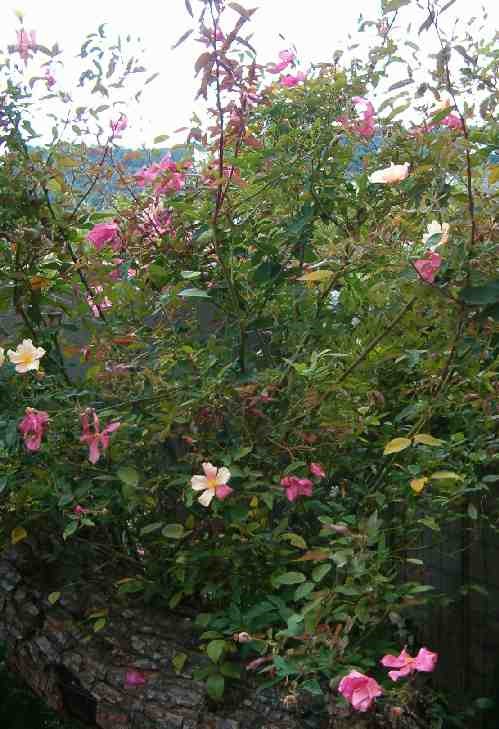 |
Fir trees smell nice when
the weather is hot. They provide shade. But
unfortunately they produce mountains of needles and
those needles will just lie there forever. That's why we
removed the fir trees around the house, but we left the
trunks or or part of them. One serves as a base to a
bird feeder, two others support a rose.
Rosa
mutabilis is wonderful in this climate. It is hardly ever
affected by aphids and is not sensitive to
any diseases. It blooms from the end of April till
winter arrives. The flowers are yellow/salmon
first and become dark reddish pink in the end.
Two drawbacks: it needs some support and it has
hardly any scent.
|
|
The other one is Rosa
banksiae lutea. It is a fast growing, pretty little rose
virtually without any thorns. Flowers in May with a
great show of small, pale yellow, powderpuff flowers. I
am thinking about buying a similar rose whose flowers
are single, white and perfumed. This type of rose is
quite resistant to drought.
I bought rosa banksiae lutea just at our local garden
center. There is a very good nursery though in Mèze -
between Montpellier and Béziers on the North East side
of an inland sea - Phillipi. Their catalogue is
really good and useful and at their nursery they give
excellent, knowledgeable information. They have a large
collection of cistus, oleander and lavender and hundreds
of other attractive plants suitable for a hot and dry
climate. |
I bought this lovely melianthus
from Gill - see below - with its large pleated gray leaves, its lovely shape and,
most important, its ability to withstand hot and dry
circumstances. When winter is over it may have look a little
bedraggled but some trimming will work miracles.
More interesting plants may be found at Gill Pounds
'la petite pépinière de Caunes'. Gill is a
British nursery woman and grows her plants in Caunes,
near Carcassone. The easiest way to contact her is by
e-mail to start with: Gill.Cei@wanadoo.fr.
It is bothersome for her to be phoned as her nursery is
at a distance from her house. If you take the trouble of
keeping this in mind she is quite willing to take care
of your wishes. She kept a Digitalis obscura
waiting for me for something like 6 months ... Try to
visit her nursery at the end of summer: she grows a Dahlia
imperialis in her private garden which is
altogether spectacular. Some 3 or 4 meters high!
|
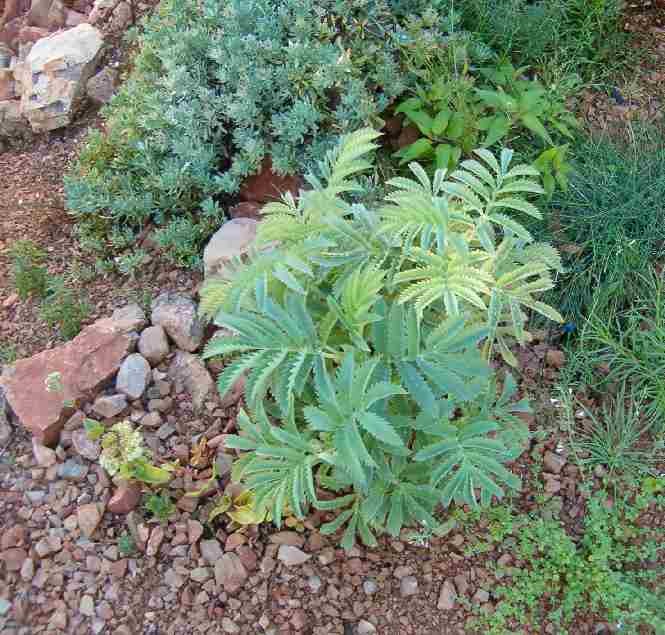 |
|
A wall with a gate
is at the entrance to our house. It is not a very pretty wall.
They put the thingummy for the EDF (= local electricity company)
box on the street side in an awkward position en the wall itself
was ugly as well. It was stuccoed and painted. Which improved
its looks. Our gardener is a great landscapist: he offered the
suggestion: cover the inside with something like chicken wire
and grow climbers on that side which will tumble over the wall
eventually. That's what we did.
We planted Solanum jasminoides, one of the best
fast growing climbers available. It starts flowering in April
and will continue right into winter with clusters of pale
mauve to white 'potato' flowers; then muhlenbeckia
whose second name is unknown to me. |
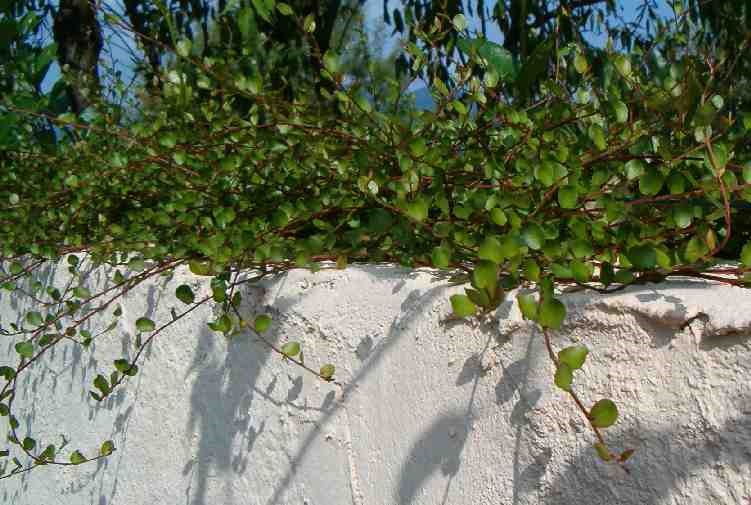 |
In my
opinion it is a pretty climber which deserves to be planted
far more often. Its only fault is becoming a bit intrusive.
Its leaves are quite small, no more than one centimeter in
diameter and more or less round. In late summer queer,
unobtrusive, waxy, cream flowers will appear. The plant's
merit is its fresh looks and its habit of growing through
other climbers like ivy which gives those an airy aspect.
Muhlenbeckia needs some support to start with and drops its
leaflets in winter. It is easily kept in shape by
trimming. |
| In their
catalogue Philippi mentions Muhlenbeckia complexa
with dull green leaves , but the leaves of this one
are shiny. |
full sized flowers
|
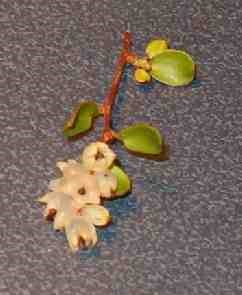 |
|
Other climbers used on
this wall are unsurpassed Trachelospermum
jasminoides, which has evergreen, glossy leaves and
perfumed white flowers in early summer, a variegated ivy (which I
may eventually regret ...), an also variegated honeysuckle: Lonicera
'Harlequin', a few short lived pink flowers matching the
leaves magnificently and two more climbers which need some
directions for use.
I bought the first one as bignonia. Surely of the
campsis family but its flowers are floss candy pink with faint lines in
its throat. The first year only few flowers appeared, but its stem
grew to be quite thick at the start of its second season and
subsequently flowered quite well from September onward. Then we had a nasty
winter, never ending lots of wind from the cold mountains and real
frost reaching -8 one night. Bignonia appeared not to have
survived. But quite late in spring suddenly young shoots grew from
the 'souche' = that part of a plant that is under the ground and
those shoots rapidly grew to some 4 meters or so. Ko had to build
a kind of trellis because they got to be too LONG. In his book Pierre Cuche
calls it Podranea ricasoliana. It is 20th September
today and the buds are promising: I shall take pictures as soon as
the flowering begins.
The second is called Pandorea jasminoides. An
amusing fact: podranea and pandorea are anagrammes (this word does
not occur in my dictionary, I'll have to ask someone ...) They are
quite alike, the same leaf shape, the same kind of flowers. Pandorea is
- in my opinion - quite a difficult plant. Possibly it is not warm
enough in this area. It flowers in spring, white flowers with a
wine red throat, pretty! This pandorea had trouble surviving the winter,
but showed up in late spring, too late to bloom. It did not grow
taller than one meter and a half, so I am a bit worried. |
A lovely hedge
!! The French law: plant your hedge at at
least 50 cms from the outward boundaries and don't let
it grow any taller than 2 meters.
Seen in this neighbourhood: a hedge made of hibiscus
bushes. In Holland I don't like hibiscus all that much
because its finished flowers turn into squishy lumps in the
rain. Here they just dry out and don't bother you. The same
goes for leaves: they drop and dry. No juicy food for worms
like in our wet country. Maybe that's why you rarely meet a
worm when poking around in the earth ...
Hibiscus guarantees a never ending amount of festive
flowers. One friend in Holland always counts the number of
flowers from her one white flowered hibiscus bush. Over 7400
in 2005!!! |
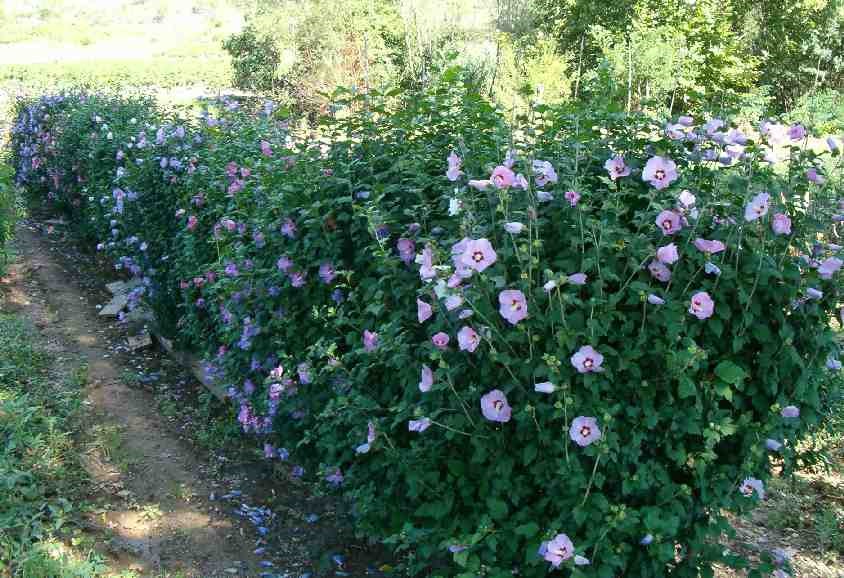
|
|
Abelia grandiflora grows well in the more
northern parts of Europe. Here it does better. It flowers forever from July to
October at least. It is not a very showy kind of shrub, rather one with
misleadingly delicate
looks. It will grow to about a meter in height in just a few years and will
eventually be 1.50. You might use it for a lovely, loose hedge.
You often see pyracantha hedges. Such a hedge will
stop a dog, thick growing and full of nasty thorns. Its flowers have an
unpleasant smell. Yet all this will be made up for by its large quantities of
orange, sometimes yellow, berries from September onwards. Blackbirds and
starlings love them. Unfortunately you do not come across blackbirds all that
often. They are probably hunted and eaten, French style ... There are not that many starlings
around either. I love a free growing pyracantha hedge in autumn.
The French are opposed to people planting pyracantha as it may be
susceptable to fire blight as are cotoneasters. Source:
Mediterrenean Gardening.
Also a hedge made of Teucrium fruticans is delightful. Teucrium
fruticans 'Azureum'
has darker flowers but will grow to lesser height, around one meter maybe, but
I might be mistaken. This bush has attractive silvery leaves and allows
unlimited pruning. Moreover the flowering season is quite long from spring to
summer and after the summer break some more. I prefer the loose hedge over the
shorn type whenever a hedge bears flowers.
|
|
I am not a professional photographer so these pictures are not much to look
at. I will replace them as soon as I can ... On the left the abelia.
On the right pyracantha tightly shorn, in the middle its free form. I do
appreciate straight, well cut hedges: yew hedges for instance, wow! I never
saw them here, but I do adore them. I would not mind to have an ordinary
conifer hedge either, Cupressocyparis leylandii I mean. I do
hate little box hedges but that's a matter of taste. In my opinion shearing
and flowering or bearing berries don't mix so if I would trim I would only
do so when the bushes in question are not in flower.
Seen once: a low rosemary hedge. Nice!
|
|
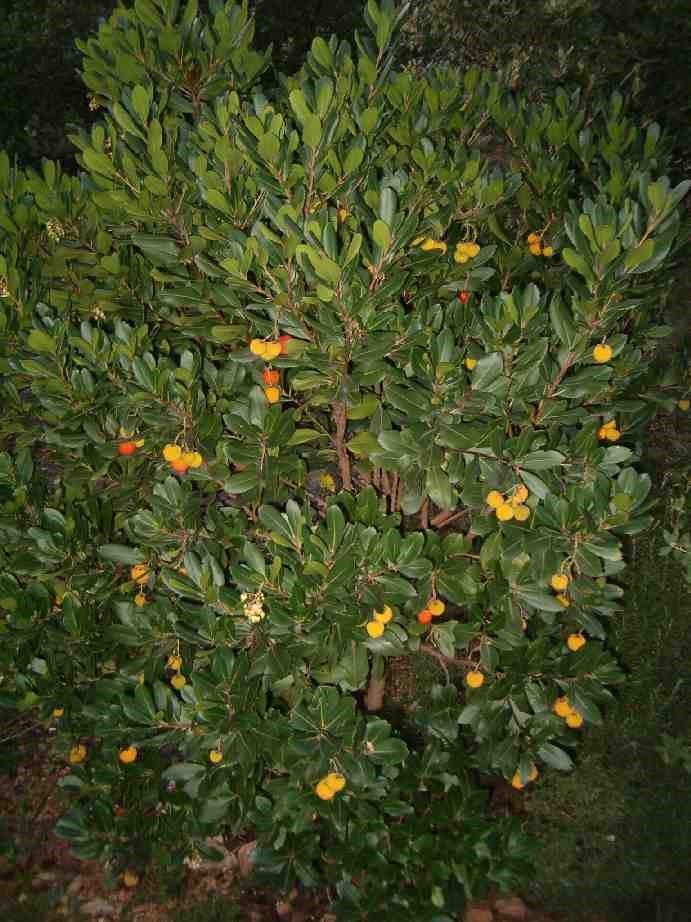 |
Arbutus
unedo, - it's called strawberry tree in Dutch - is a common native
bush around these parts. An evergreen which may grow into a small tree. At some
time of the year it is prettily decorated with both flowers and fruits
though the two in our garden bear fruit with just one flower and flowers with
just one fruit ... |
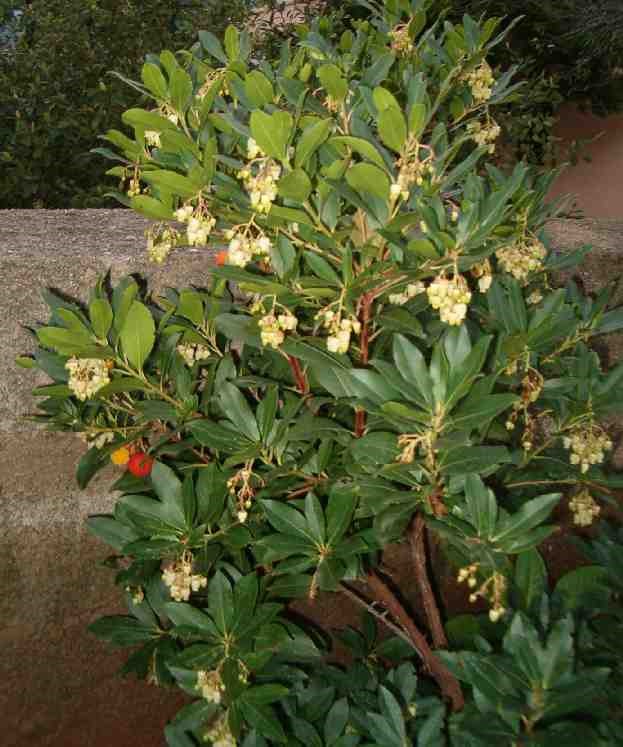 |
The bush on the left was present when we came here but
completely hidden from sight by the ever present ever hateful kermès
oak! A nice surprise, but it took me days of hard labour to provide it
with the attention it deserved, for it is at its loveliest when used as a
solitary bush. It has now had three years of freedom and has become quite
beautiful.
Next year it will behave as it should: flowers and fruits at the
same time. The one on the right I brought from Holland with my first choice of
bushes and it has done well. The fruit is suitable for consumption, but rather
made into jam or something than raw when it may cause problems to your stomach. |
|
|
I always thought that plants with urn shaped flowers - gaulteria, enkianthus -
need acid soil, so you would not expect arbutus to do so well here.
Last week I spent a few days in Holland. 30th October, gorgeous weather. So
I had a long walk through my native town and saw Viburnum
tinus in full bloom.
This is a native bush in the Languedoc and is called laurier tin.
But here it will flower in spring, March onwards, maybe earlier in a mild
winter (which we have so far never experienced yet ...). At the moment 3rd
November, it is covered in buds with the odd dark blue berry still among them.
You can do a wonderful winter arrangement from these combined with Pistacia terebinthus
(should not it be terebintha?), which has lovely purplish leaves in winter.
With a bit of luck your bush will have pink berries in summer, but -
unfortunately - no delicious pistachio nuts. I suspect the pink berries are
only given to female bushes!
|
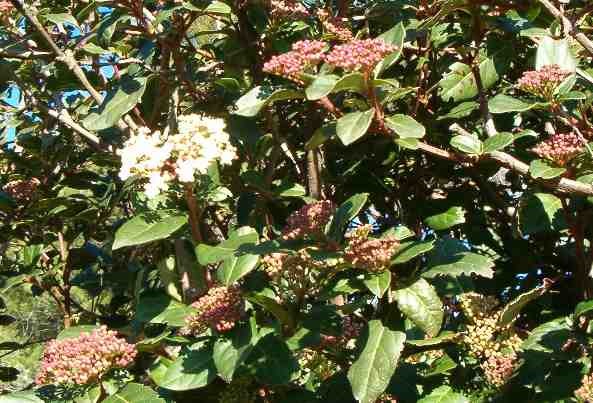 |
Today is November 22nd. October has been too wet, November
is quite cold. The weather is radiant though.
Viburnum tinus, as indicated above, is full of buds, but
there is one headstrong fellow abundantly blooming!!! |
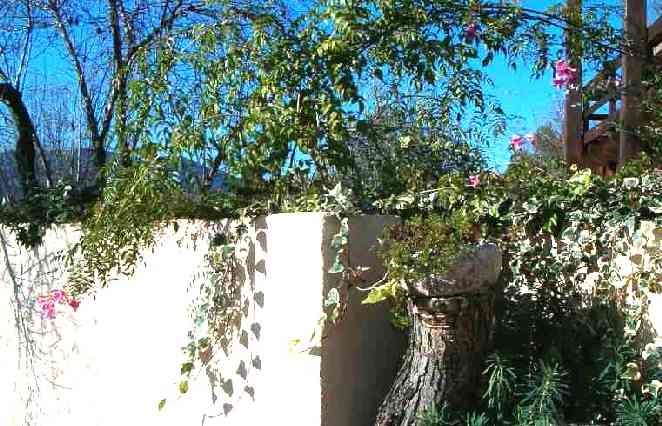 |
|
Podranea
- on the right -is still in flower just like the alstromerias.
|
|
30th November. So far it has been
a pretty unpleasant fall. A lot of rain in October which is
usually a lovely month and a lot of cold in November. But mimosa
has been spotted already.
Its flowering lasts for a long time. The one on the photo is
down in the village, always the first to start. At my
neighbour Gilbert's the next one comes a little later. Last
one is at Odette's, more or less opposite our house.
Yet it is the same tree: Acacia dealbata. They
are lovely, but a tree to be warned about before planting.
It will produce a lot of runners and them very strong!! It
is not such a good idea to plant close to your house.
There is a lot of variation in the colour of the leaves,
sometimes just plain green, sometimes yellowish and
sometimes blue grey and that's my favourite. It is not all
that easy to get it going. I have been told you should plant
it when in flower ... watering must be essential at the
beginning.
|
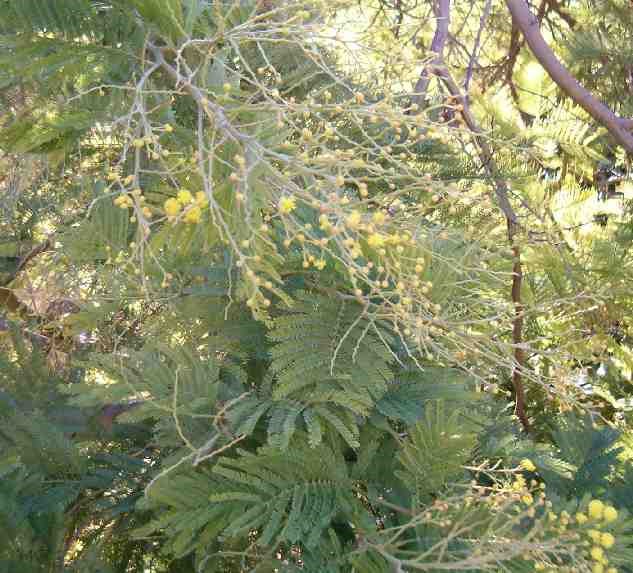
|
|
I myself have fallen in love with: Acacia fimbriata,
leaves greyish and large lemon coloured fluffy flowers. Seen
for sale only once at 80 euros!! I have found somebody
selling seed (in Australia) who is going to send me some one
of these days. And on the internet I found a suggestion to
keep the fluffiness in the flower when cut for indoors:
cut the stem on an angle, put in boiling water immediately and cover
with a plastic bag until the water has cooled down.
|
26
januari 2006 This winter has been rather
cold, esp. in December. Nothing much happened during
our long absence. But a little down the road there is
a house with a now spectacular hedge of Viburnum
tinus! Another great idea. As you may see it
is still not really far gone in comparison to 9! weeks
ago. I like them best at this stage. The leaves turn
somewhat purple with cold and its flowers are only
half open. Bees are busy with them though!
The mimosa which started flowering end of November last year has not gone any further: frozen!
The ones closer to our home are still in bud.!
|

|
|
|
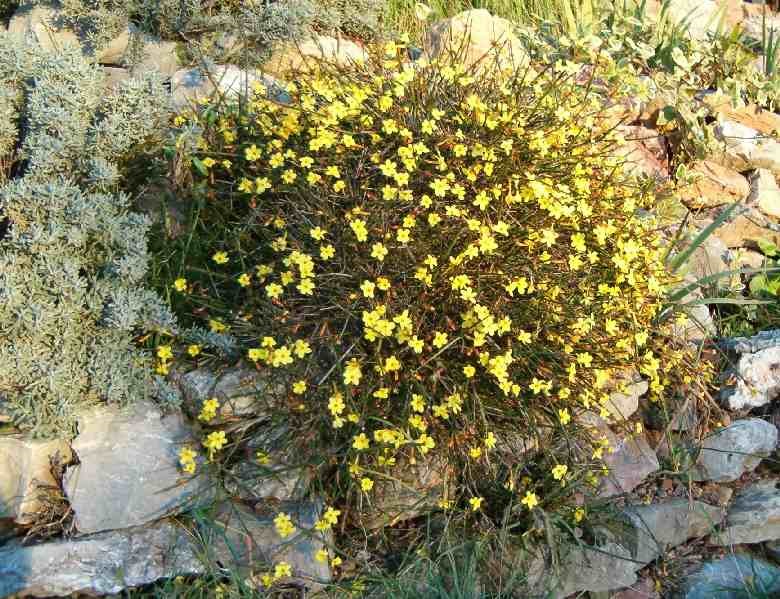 |
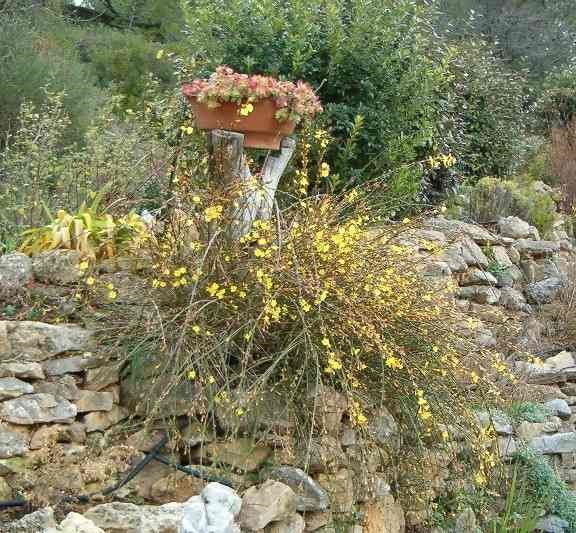
|
I don't like - 26th January
- winter jasmin, Jasminum nudiflorum
much, but it looks cheerful in a bare winter garden.
My neighbour sometimes prunes it back severely
(left) but elsewhere she lets it grow freely (right).
The bush does not seem to like growing upwards which
makes it awkward to use. Unless you are able to build
stone walls like my 80+ neighbour!! where it looks
rather pretty. |
|
|
The other day I found a long sought after
camellia in a garden centre in Narbonne. This one is
supposed to flower in late autumn, but the one I bought doesn't keep
to the rules ... Its nearly full name is Camellia sasangua
'Kanjiro', also known as c. sansagua and the g may be replaced by a q if you
wish. The flowers are not very large, 6 cms or so. The one I had
before, in my Dutch! garden, was white, but I even prefer this one.
Its complete full name, that's to say the addition for its colour
like 'Marie Antoinette' or something, was not mentioned.
Camellias need more or less acid soil (terre de bruyère) a position
sheltered from fierce winds and hates morning sun on her leathery
leaves esp. after frost in the night. Should be kept slightly moist
with preferably rain water.
I keep her in a pot so that she may be rushed into the garage when
hard frost is expected, but just covering up with a bit of
gardeners' fleece is sufficient if the frost is too slight to
freeze the roots.
|
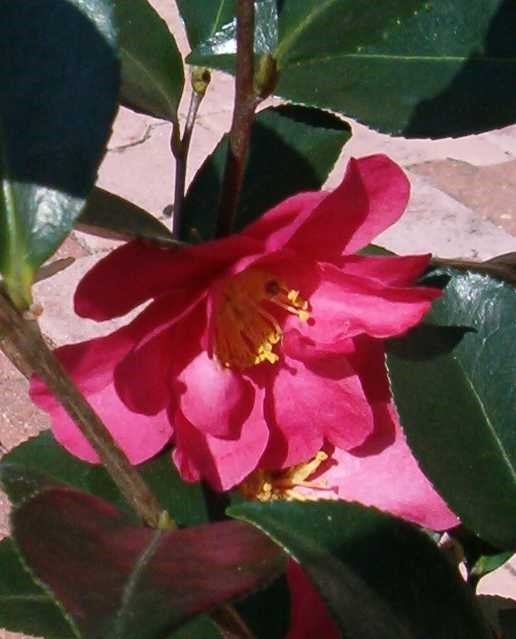
|
|
|
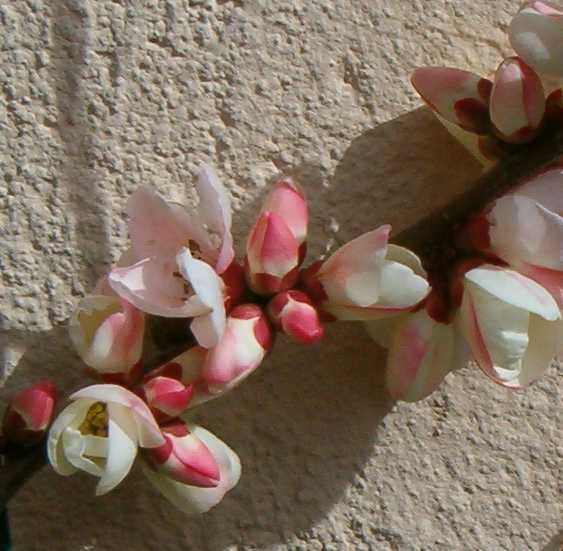
|
Chaenomeles speciosa 'Appleblossom'
aka 'Moerloosii' should be put against a
darker wall. I fell in love with her - can't be a him - on a photo
against a brick wall combined with flowering peach coloured hyacinths. Isn't
she gorgeous? I brought my bush from Holland as one of five allotted
bushes ... She does not grow very fast, has just this year got
quite a few flowers, so you need patience for this one. On the other
hand chaenomeles does really well in this area, flowers early in the
year and comes in lovely colours, oranges and reds mainly. They can
be used wherever you wish, but look nice against a wall. This one is
the yearly home of a fat female praying mantis showing up in July.
Last year's Truus (as I always call them) left a huge 'egg'. |
|
| At the end of March
things begin to happen. A small tree full of white
blossom along the road is unknown to me, but peasant to the
eye.
Right: detail. |
 |
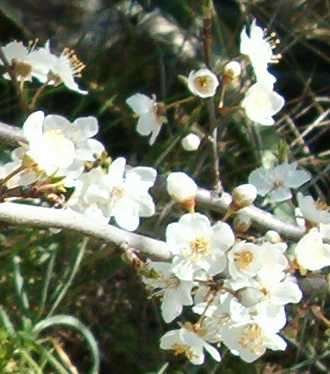
|
|
|
 |
Cronilla glauca - left
- is one of the best shrubs for these parts. It flowers at the end
of March
for three or four weeks. It is a smallish bush with attractive
bluish leaves and does not need any care at all, though you could
prune it back a little once in a while. It self seeds as well and
the seedlings will grow into mature shrubs in a few years only. On
the right a delicate, lemon coloured variety offered by
Philippi. |
 |
Cercis siliquastrum is called tree of
Judas in the Netherlands. It is a native species that flowers in April
and belongs to the leguminosa
family. Interesting detail: the flowers are often right on the stems
of the small tree or large shrub. Requires no attention, only
enjoyment!
Its leaves are bronze at first, then turn a blue green. The tree has
a nice shape. |
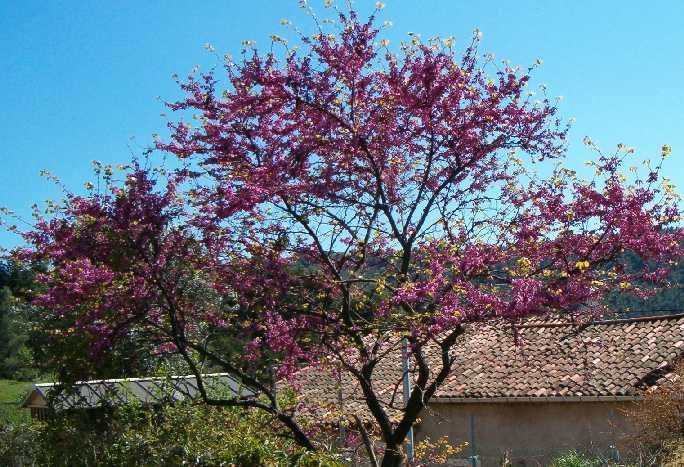 |
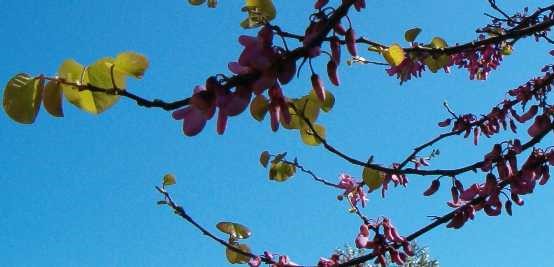
|
| At the end of
April the time of the cistus
is coming. It starts with Halimium halimifolium in
this garden. Very closely related to cistus.
At Philippi's you can buy many, many
different types. They are very good plants for this part of the
world. You have to make them start, that's to say they need
attention in their first weeks after planting, some watering too.
Best time for planting is October, but best time for buying is May
...
With a bit of luck you can make cuttings. I
always try! |
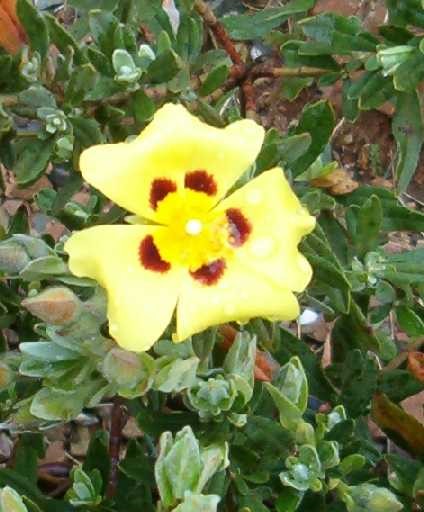
|
|
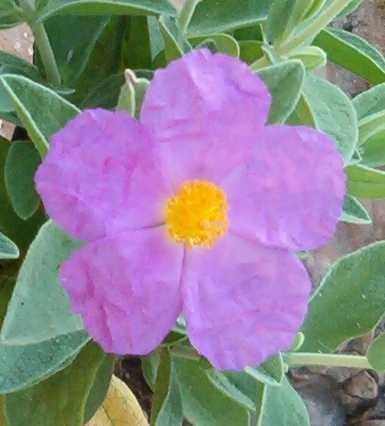
|
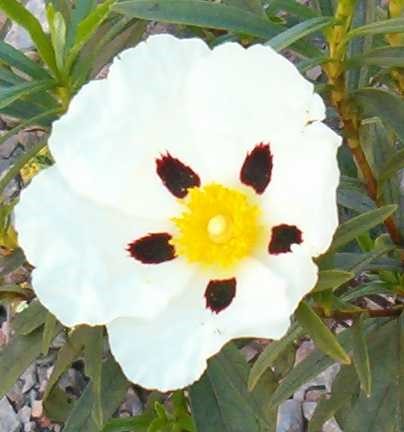
|
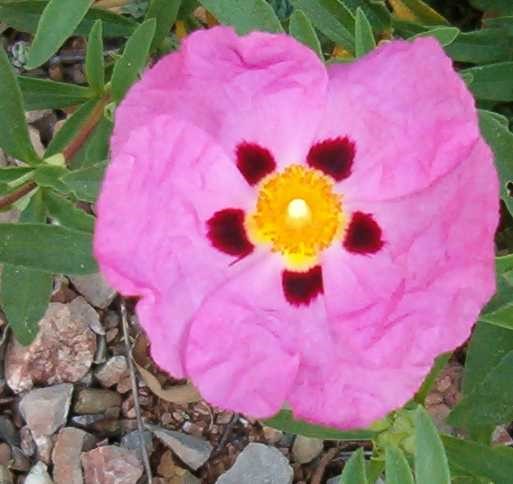 |

|
|
Cistus albidus , a native. Albidus
because of its whitish felt leaves.
|
Cistus ladanifer has sticky
leaves. Its flowers are often eaten by beasties and will be
decorated with small round holes!
|
Cistus x purpureus will
soon grow into a large bush. Mine grew to one by one meter in just
three years.
|
Cistus 'Barnsley Pink'.
|
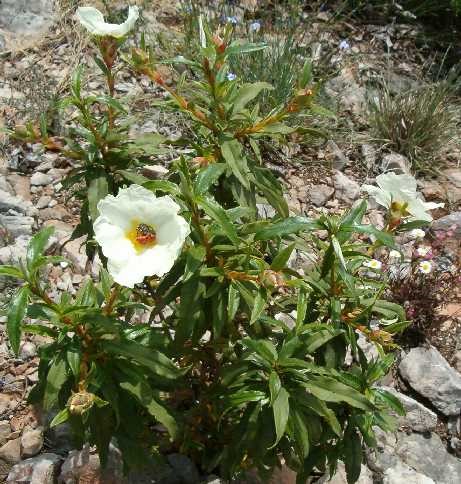 |
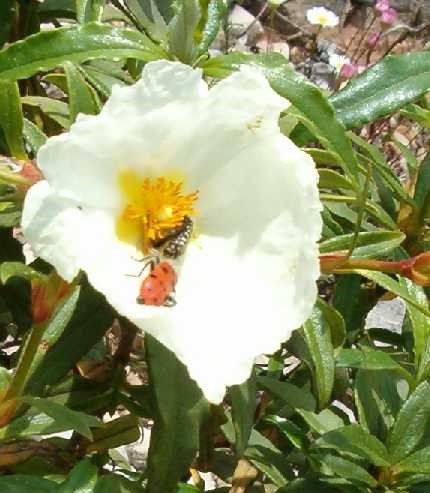
|
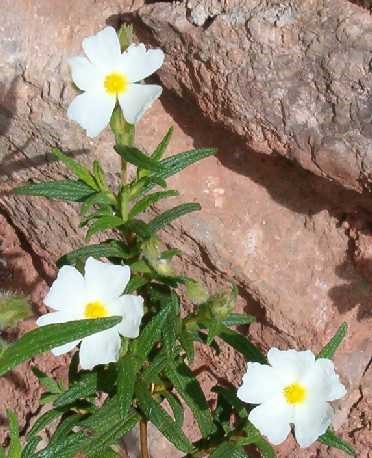
|
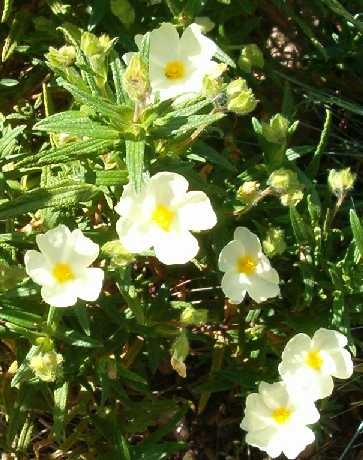
|
|
Cistus laurifolius is a very strong
plant. It grows here on top of the rocks in full sun all day long! |
Detail of its flower visited by all kinds of beetles
and things.
|
By far the best known is native Cistus
monspeliensis which does not need any care at all. It is not
a plant with a long life though.
|
The subtle creamy colour of Cistus
monspeliensis f. flavescens 'Vicar's Mead' makes it to be my
nearly best loved one!
|
| A flowering ordinary Cistus monspeliensis
is a lovely thing. It does not ask for any attention either, but as
mentioned before, it does not live long. I wonder if any pruning changes
this fact.
On the right an app. one year old, and 20 cms tall seedling of spartium
which is discussed below. When younger they have more leaves. Pull
them out as soon as you find them if you don't want them everywhere. Later
on it becomes rather difficult as they have a very tough taproot. |
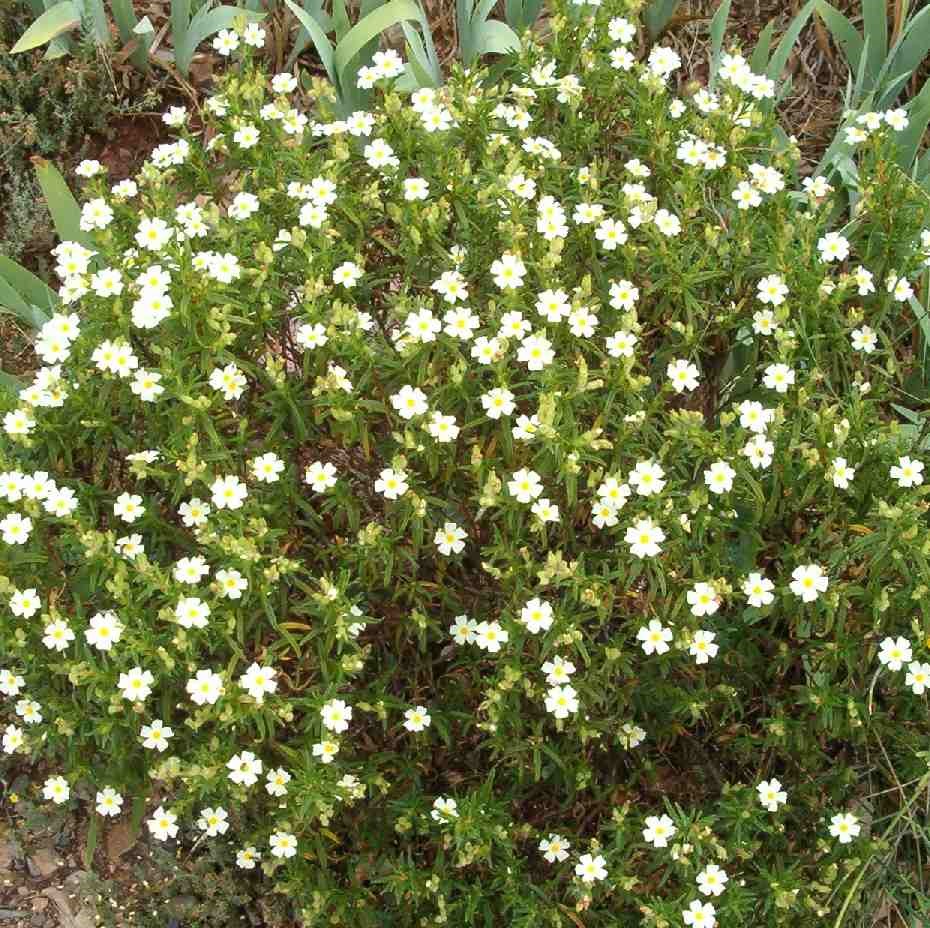 |
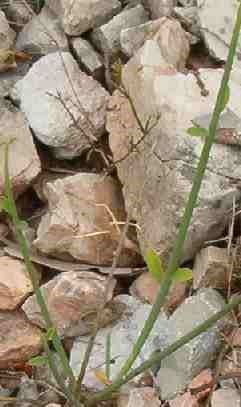
|
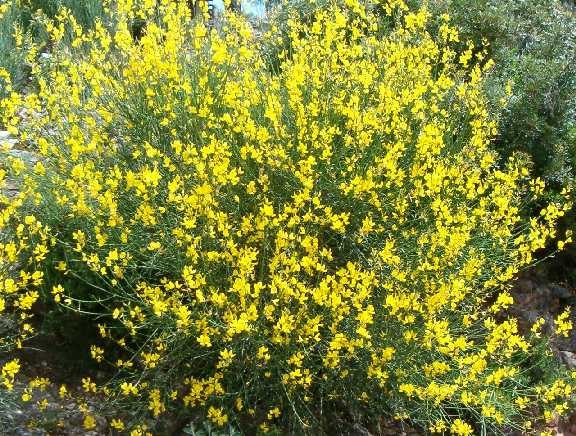 |
When Spartium junceum is in
flower the whole area smells like heaven! There bare branches - hardly any
leaves - are not very attractive if you let them become tall, so it is a
good idea to saw the whole plant off once in a while to make it have a
good shape.
|
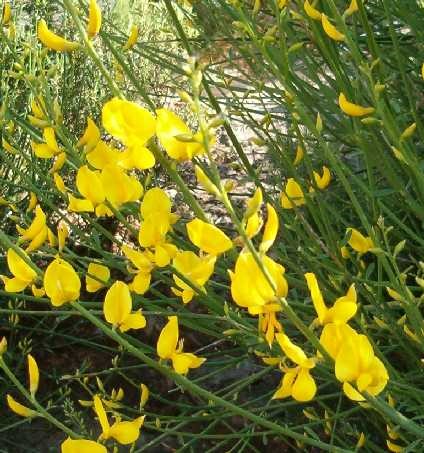
|
|
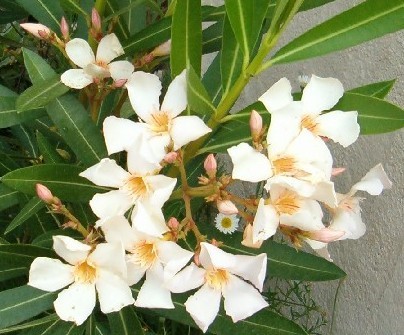 |
Time for oleander! Nerium 'Angiolo Pucci' is
one of my favourites. Unfortunately it has no perfume to
speak of. It does not grow higher than 1,25 m. For its
smell I love Framboise', dark rosy red,
always a great colour in the garden like creamy yellow and
lavender. I also have great expectations of 'Barcelona' which
is an unusual colour between lilac and pink.
Very easy to make cuttings! See that part in the various
department.
Philippi has many oleanders to choose from. |
|
Two lovely climbers: first right Trachelospermum
jasminoides which has a lovely perfume and flowers from the end of
May . You can
already see that the tiny leaves of muhlenbeckia, discussed
earlier, will cheer it up when the flowers are finished.
Solanum jasminoides is a strong grower. It flowers from May
right to the
end of October but lacks the lovely
perfume. Also in pure white. This one died in a very dry summer. |
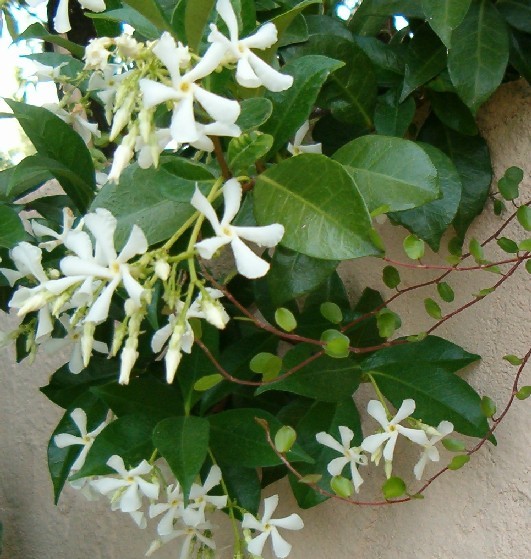
|
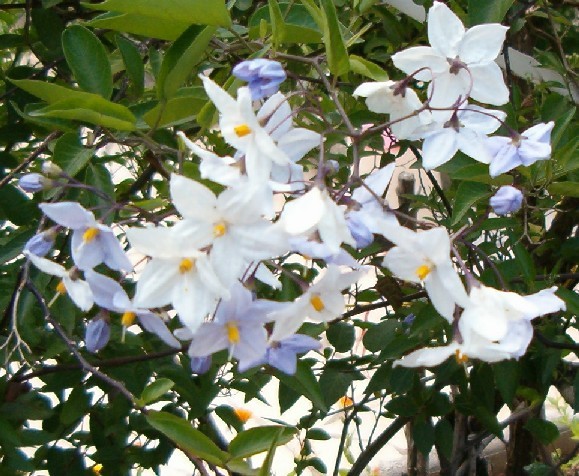 |
|
|
|

|
When we first had this house I asked a
local gardener, Daniel, actually more of a landscape person, to help
me do the things in the garden that I could not do myself and advise
me on how to do them. I came to like him a lot! With his pipe and
his funny thoughts once in a while. His idea for getting rid of the
hated kermès oak was: dynamite!
The wall in front of the house was as ugly as you can think of. A
mason plastered it and my husband put up a lattice: Daniel's idea
was to cover the wall from the inside and allow the plants hang over
at the outside. Which we did. This part of the garden, by the way,
is watered regularly.
A.o. I planted a tiny muhlenbeckia, trachelospermum, a
variegated ivy, honeysuckle and a podranea which does not show up
before May, but reaches two meters in four weeks!The ivy of course grew fast. It is already huge and needs pruning
now and then.
In the picture you see on the left at the back muhlenbeckia and
growing through it trachelospermum, planted 3 1/2 years ago.
in front of it an unknown rosy pink oleander, 'Framboise' is still
small and won't flower yet; the yellowish stuff is parsley which I
love for its taste ànd for its lovely flowers; geranium endressii
somehow found its way into this and grows through salvia 'Scarlet
Pineapple'. The last one will not flower until after the summer
break. |
| Somewhere in the neighbourhood I
saw a loose hedge of oleanders in various colours most of them
with simple flowers. Quite lovely. |
 |
|
| Isn't she gorgeous? It is rather
difficult to take a good picture of her colour, but in the large
photo it is more or less right. She is called 'Barcelona' and
is available at Philippi's. She starts flowering in the middle of June.
In the far right photo you can see she is growing with Saponaria
officinalis, a common 'weed' and Allium
sphaerocephalum which I am still in doubt about as it looks
suspiciously like the wild alliums that I have been trying to
eradicate from the garden ... |
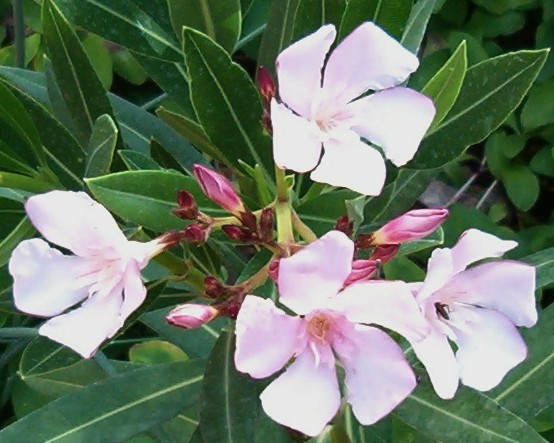 |
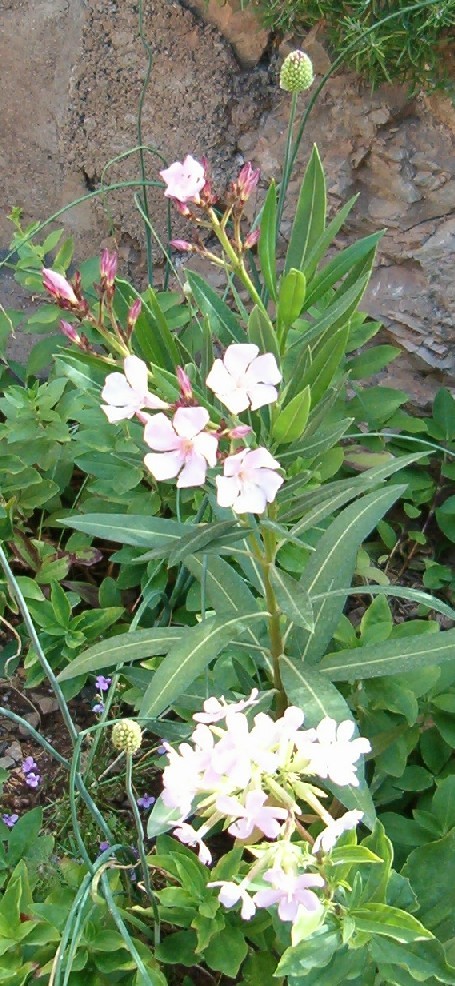
|
|
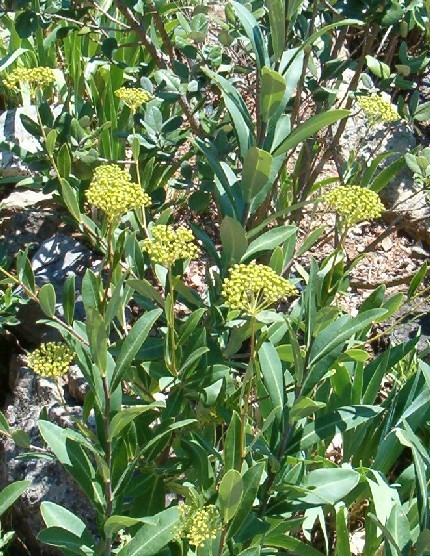 |
Bupleorum fruticosum more
or less grows anywhere in the wilds here. I consider it a valuable
plant as it is modest in coloration so it blends well with about
everything, it has no needs in respect to fertility of the soil or
water and the flowers are excellent for arrangements.
It is always difficult to do but cutting it right to the bottom
produces a lovely full bush. Like the spartium (broom)
mentioned above it self seeds well. As I love it I have never yet
tried to pull one out. |
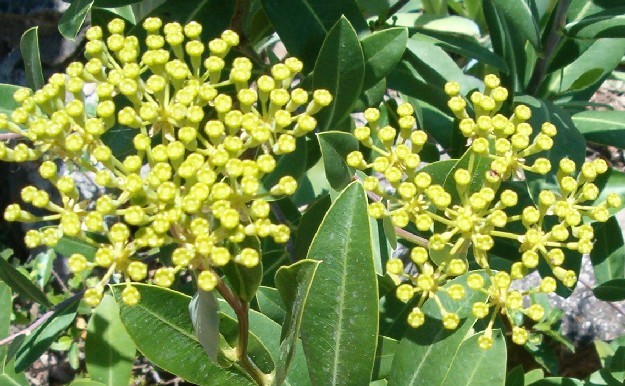 |
|
| In my neighbour's garden grows a lovely tree called Albizia
julibrissin. My gardener told me it was a disaster as its
fluff would appear all over the house, but I have never found any
even in my garden. Yet it is not very far from our place! Its shape
is lovely, African = umbrella. The unusual second part of its name
is derived from Persian and means soft silk. There is also a
more pink flowered one. |
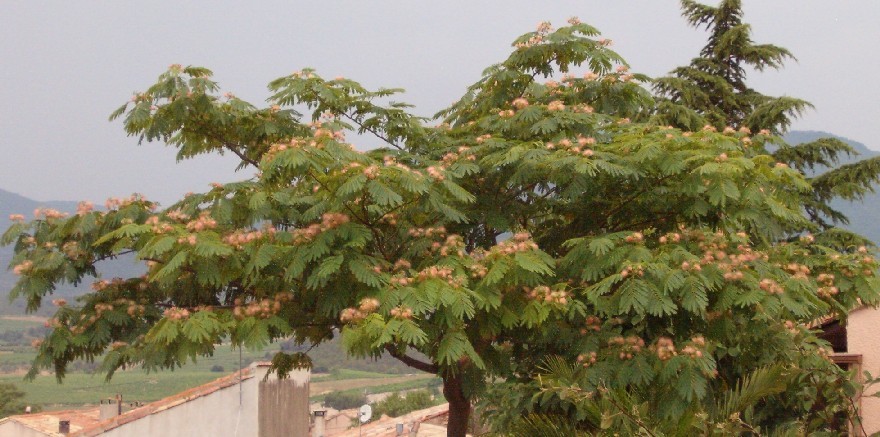 |
|
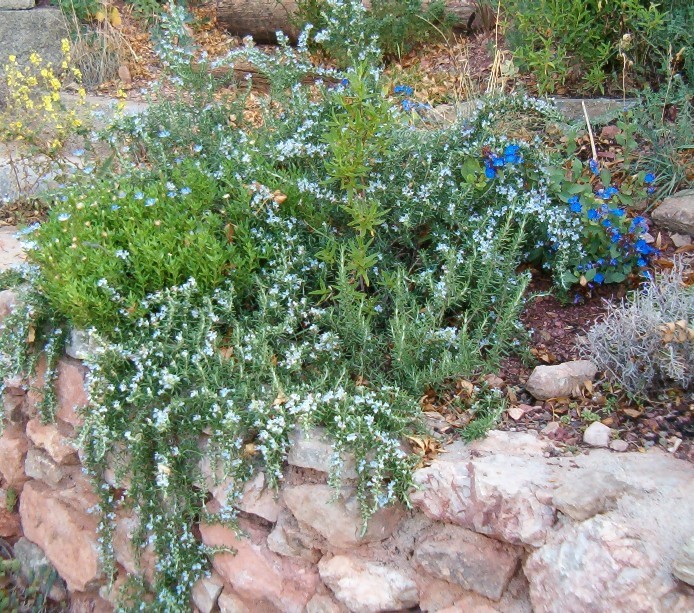 |
September 5th Rosemary
is such a common bush in these parts that I have so far hardly ever
mentioned it. Lately we were ordered to clean up our land to prevent
fires. It means that I have to take out a great number of old
bushes, often rosemary which stops flowering when old. This is a
lovely creeping form Rosmarinus officinalis repens. It
flowers twice a year - spring and fall - and some more in between,
like the felicia growing in it on the left, but barely
visible. The wild yellow verbascum on the far left also has a long
flowering period as has the bright blue ceratostigma: this one
starts in July and will go on till even November. |
|
| October 16th Autumn
is usually quite beautiful in these parts. The vineyards however
were, I think, this time subjected to one night of frost and became
sadly brown and withered. Most years they show glorious colours,
reds and yellows and purples. Fortunately the Virginia creeper is
more beautiful than ever. Its Latin name is Parthenocissus
tricuspedata. This is a climbing bush you have to
think long and carefully about before planting as its multiple 5
fingered greedy hands will cling to your walls and are very
difficult to remove! It is also a very fast grower. Much like ivy.
The tree on the left is lagerstroemia, a bit stiff in
shape but with a long flowering period in July/ August when there
are not so many flowers about. Mostly pinks. |
 |
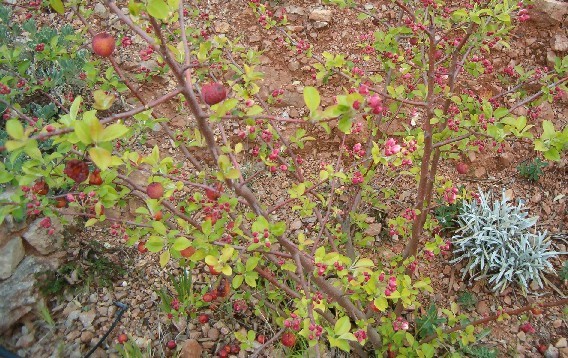 27 27 |
March
My neighbour gave me a sprig of a kind of apple tree
some years ago. I have never been able to find out its
Latin name. I planted it in a very poor spot which is
rarely watered but it seems to be thriving. It flowers
well and after that the small reddish apples are
eaten by blackbirds and thrushes, occasionally seen in
cold winters.
Last winter was a typically warm so there were no
blackbirds and the apples are still there though it is
nearly in flower. Unfortunately the lovely combination
of budding flowers and last year's apples does not show
well against the background of reddish soil. |
|
|
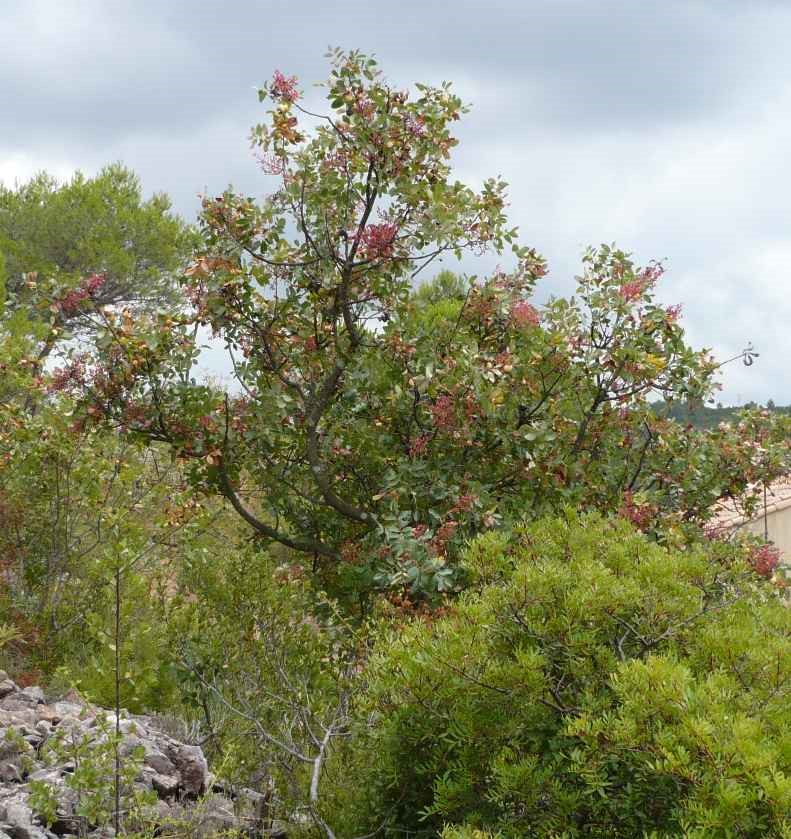
|
End of August.
Only a few more days and the second 'spring' will
start. Let's pay some attention to
Pistacia atlantica. I don't think
much of it in spite of the fact that it is a tree often
mentioned in the Bible. I don't like its shape, it is untidy
and in winter it drops unappetising clumps of ? But!! It
supports horrible droughts and is indestructible. Its leaves
are quite nice, a pleasant shade of blue green on reddish
branches.
|
In September however there are a few blue or
pink berries on the tree which seem to be a delicacy to many
birds.
I have seen quite a few youngsters of quite
unusual birds whose name I don't know in English, sorry, one
being a flycatcher, dark with white spots in the wings.
|
|
|
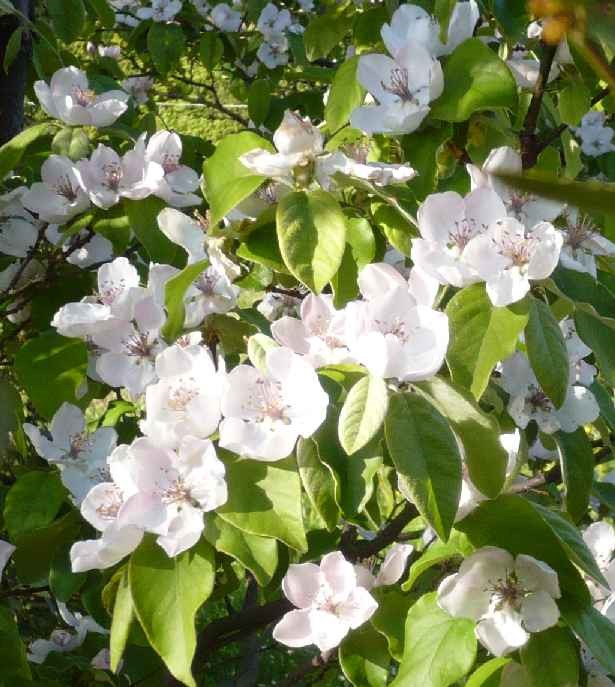 |
In one of my neighbours' garden some medlar trees are
in full bloom.
What a gorgeous tree: its flowers are 4 cms in diameter white
flushed with some pink. Each flower stands on its own. It is end
of March 2008. They are done in only a few days, but
quite worth attention! It is the first time though I see them
covered in so many flowers. Mispelus germanica. |
|
|
|
|
| top
|
|
|